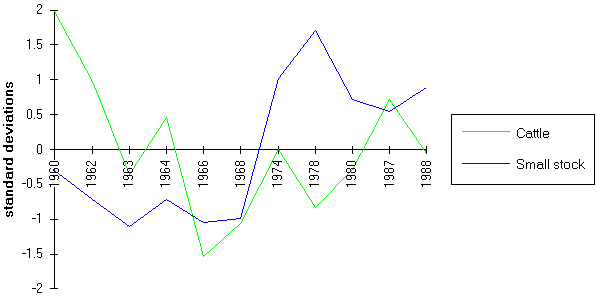
However, there is not necessarily a uniform consensus among the members of the Lund University research group. Olsson and Rapp (1991) address the northward movement of grassland following the 1982-84 drought. “Recovery can be attributed in part to increases in rainfall, but it is important to note that rainfall during the period 1985 - 1987 remained below the long-term average for the region. Thus, it seems that an important contributor to the recovery has been the low level of exploitation in 1985 - 1986, owing to the large numbers of people and animals that had been wiped out during 1983 - 1984.... [T]he desertification that occurred in the study area [Kordofan Province] during 1982 - 1984 was sufficiently severe to require for its recovery a period of several years characterized by a combination of improved rainfall and reduced exploitation.”
The 1968 - 1973 Sahelian drought was as destructive to livestock as the 1982 - 1984 drought that Olsson and Rapp (1991) refer to; Mattsson and Rapp (1991) state that millions of cattle died in the Sahelian zone. The figure below shows the typical pattern of livestock recovery after major die-offs; note that recovery of small livestock flocks precedes that of cattle herds. Pastoralist societies do not recover quite as quickly as some might assume, and neither does anthropogenic forcing of land degradation. It will take longer than Lund University's 15-year study to corroborate their assertion that desertification is a myth.

Standard deviations of Ngorongoro Crater Conservation Area livestock census data around a mean of 123,680 head for cattle and 113,795 head for small stock. Major drought occurred in this area of Tanzania from 1970 - 1973, 1975 - 1976, and 1983 - 1984. After major livestock die-offs following severe drought, households typically reacquire small stock before investing in cattle. Data source: McCabe, 1990.
Mattsson, J.O. and A. Rapp, 1991. The recent droughts in Western Ethiopia and Sudan in a climatic context. Ambio 20:5, 172-175.
McCabe, J.T., 1990. Turkana pastoralism: a case against the tragedy of the commons. Human Ecology 18:1, 81-101.
Olsson, K. and A. Rapp, 1991. Dryland degradation in Central Sudan and conservation for survival. Ambio 20:5, 192-195.
Pearce, F., 1992. Mirage of shifting sands. New Scientist, 12 December, 38-42.
Schlesinger, W.H., J.F. Reynolds, G.L. Cunningham, L.F. Huenneke, W.M. Jarrell, R.A. Virginia, and W.G. Whitford, 1990. Biological feedbacks in global desertification. Science 247, 1043-1048.
Skarpe, C., 1991. Impact of grazing in savanna ecosystems. Ambio 20:8, 351-356.
Sollod, A.E., 1990. Rainfall, biomass and the pastoral economy of Niger: assessing the impact of drought. Journal of Arid Environments 18, 97-107.
Tucker, C.J., H.E. Dregne, and W.W. Newcomb, 1991. Expansion and contraction of the Sahara Desert from 1980 to 1990. Science 253, 299-301.
The Table of Contents of my work on desertification and food security is available.
 Back
Back  Onward!
Onward!
This site last updated August 10, 1997.